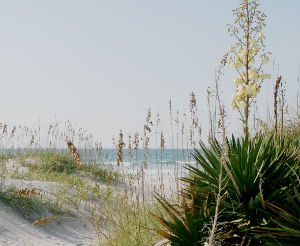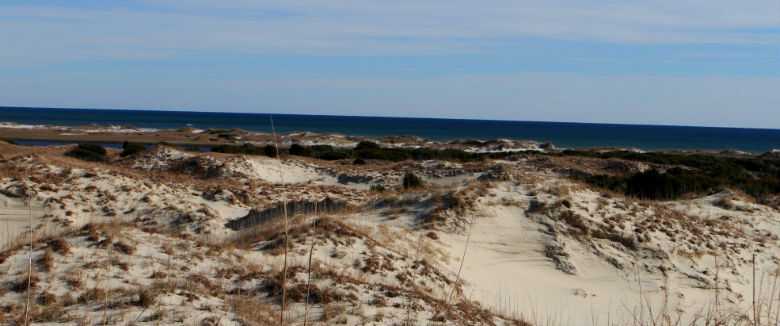Reprinted from the Tideland News of Swansboro
 The state budget will provide $3 million of the $10.3 million price for the addition of 289 acres to Hammocks Beach State Park. Photo: Sam Bland |
SWANSBORO — The 2014-15 North Carolina budget recently signed by Gov. Pat McCrory includes $3 million for the purchase of the long-sought 289-acre mainland addition to Hammocks Beach State
Park.
Supporter Spotlight
That money, to come from the sale of general obligation bonds, brings
the total available for the purchase to $5.9 million, well on the way to the full $10.3 million price worked out earlier this summer in a court settlement.
David Pearson, president of Friends of the Hammocks and Bear Island, the park’s volunteer support group, said recently that the previous $2.9 million came from the state Parks and Recreation Trust Fund last year. That agency could kick in more this year.
As a result, he said, it now appears everything is “set in motion” to
complete the deal for the land along and near Queens Creek by the end of the year or sometime early next year.
“I’m very happy the money was included,” Pearson said. “It leave us getting close to what we need, and we think that with some money from the military and a little bit from private sources, we’ll get there.”
Attorneys for the state and Charles T. Francis, attorney for the Hurst and Turner families of Onslow County, signed the negotiated agreement on June 11, signaling the end of a long legal battle.
Supporter Spotlight
The first move under the agreement came that same day, when the attorneys filed a “joint motion to dismiss” a Supreme Court review in the lawsuit, and that motion was accepted.
Under the agreement the state Superior Court, where the case has resided since 2010, will be asked to end the case and award the property to John H. Hurst and Harriet Hurst Turner. It would be up to them, Pearson said, to then
obtain clear title to the land, which might have claims by others, including members of the Sharpe family. If Hurst and Turner can obtain clear title, they would then sell the land to the state for $10.3 million.
However, Pearson added, if clear title cannot be obtained, the agreement calls for the state to condemn the property and still award the money to Hurst and Turner.
Pearson said Friday that he hopes the remaining court proceedings will be scheduled within the next month or two.
The park is currently made of four different areas: the 30-acre mainland, which is the hub and home of the visitors’ center and ferry dock; Bear Island, an 892-acre largely unspoiled barrier island with a ferry landing, an ocean beach with lifeguards and a restroom and concession facility; Huggins Island, a 225-acre maritime island, home to a historic Civil War battery, at the mouth of the White Oak River in Bogue Inlet; and 23-acre Jones Island, seven miles northeast of Bear Island at the mouth of White Oak.
The acquisition would represent about a 25 percent increase in the total size of the park. More importantly, though, it represents close to a 1,000 percent increase on the mainland; the 320-acre combined and very accessible site would put it roughly on a par with the 400-plus acres at Fort Macon State Park east of Atlantic Beach and at Jockey’s Ridge State Park on the Outer Banks.
The modern history of the land goes back to the early 1900s, when Dr. William Sharpe, a New Yorker, bought 4,600 acres along Queens Creek near Swansboro and hired John L. Hurst, son of a slave, to manage it. Sharpe planned
to give the property to the Hurst family when he died, but the family eventually convinced Sharpe to donate it to a black teachers’ group.
 Bear Island, pictured here, is the largest area of Hammocks Beach State Park with 892 acres. The land acquisition would represent about a 25 percent increase in the total size of the park. More importantly, though, it represents close to a 1,000 percent increase on the mainland, which is currently only 30 acres. Photo: Sam Bland |
The teachers association in the 1950s established the Hammocks Beach Corp. to manage the property in trust for its members. The property deed stated
that if it couldn’t manage the property properly, the corporation could transfer the land to the N.C. Board of Education, but that if the board turned it down, it would go to the Hurst and Sharpe families.
The recent legal history began in 2006, when the Hurst heirs, Harriet Hurst Turner and John W. Hurst, sued the corporation, claiming it had failed to properly administer the trust, and sought the return of the 289 acres to the
family.
In October 2010, a judge in Wake County Superior Court removed the corporation as trustee. But in early January 2011, the same court asked the state education board if it wanted the land. Although it had previously
rejected the trusteeship twice, the board then said it would accept it, a move that could have cleared the way for the land to become part of the state park.
However, Harriet Hurst Turner and John H. Hurst appealed, and the state Court of Appeals placed a temporary stay on the lower court’s ruling, citing the board of education’s previous decisions not to accept the property.
Because the appeals court ruling was unanimous, there was no automatic right of review by the N.C. Supreme Court. However, state Attorney General Roy Cooper, on behalf of the education board, filed a petition for that review, and
the Supreme Court accepted it before approving the motion to dismiss on June 11.
Pearson has hailed the agreement as fair to the families and great for the state.
“It’s been a dream of mine and of Sam Bland (former Hammocks Beach State Park superintendent) for 20 years, and we’ve been working on this for at least eight years.”
The ultimate goal, Pearson said, is to have a boating access site, similar in scope to the regional facility in Emerald Isle, camping, trails and much more on what some have called the most beautiful undeveloped property left
along the state’s coastline. In addition, great swaths of the land should remain undisturbed, and some sections might be restored to its previous natural state.
“Keep in mind that the things I’ve mentioned are just a vision, and we have to go through a master planning process, of course, but once we get all this done, it will be great for Swansboro and for Onslow County,” Pearson said.







